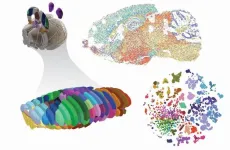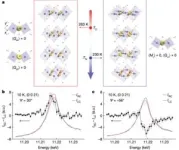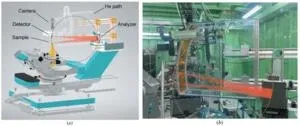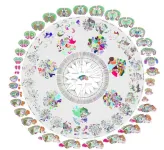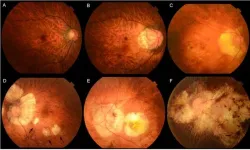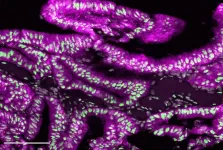(Press-News.org) LA JOLLA (December 14, 2023)—Salk Institute researchers, as part of a worldwide initiative to revolutionize scientists’ understanding of the brain, analyzed more than 2 million brain cells from mice to assemble the most complete atlas ever of the mouse brain. Their work, published December 14, 2023 in a special issue of Nature, not only details the thousands of cell types present in the brain but also how those cells connect and the genes and regulatory programs that are active in each cell.
The efforts were coordinated by the National Institutes of Health’s Brain Research Through Advancing Innovative Neurotechnologies® Initiative, or the BRAIN Initiative®, which ultimately aims to produce a new, dynamic picture of mammalian brains.
“With this work, we have not only gained a lot of information about what cells make up the mouse brain, but also how genes are regulated within those cells and how that drives the cells’ functions,” says Salk Professor, International Council Chair in Genetics, and Howard Hughes Medical Institute Investigator Joseph Ecker, who contributed to four of the new papers. “When you take this epigenome-based cell atlas and start to look at genetic variants that are known to cause human disease, you get new insight into what cell types may be most vulnerable in the disease.”
The NIH BRAIN Initiative was launched in 2014 and has provided more than $3 billion in funding to researchers to develop transformative technologies and apply them to brain science.
In 2021, researchers supported by the BRAIN Initiative—including teams at Salk—unveiled the first draft of the mouse brain atlas, which pioneered new tools to characterize neurons and applied those tools to small sections of the mouse brain. Earlier this year, many of the same techniques were used to assemble an initial atlas of the human brain. In the latest work, researchers expanded the number of cells studied and which areas of the mouse brain were included, as well as used new, single-cell technologies that have only emerged in the last few years.
“This is the entire brain, which hasn’t been done before,” says Professor Edward Callaway, a senior author on two of the new papers. “There are ideas and principles that come out of looking at the whole brain that you don’t know from looking at one part at a time.”
To help assist other researchers studying the mouse brain, the new data is publicly available through an online platform, which can not only be searched through a database but also queried using the artificial intelligence tool ChatGPT.
“There is an incredibly large community of people who use mice as model organisms and this gives them an incredibly powerful new tool to use in their research involving the mouse brain,” adds Margarita Behrens, a Salk research professor who was involved in all four new papers.
The special issue of Nature has 10 total NIH BRAIN Initiative articles, including four co-authored by Salk researchers that describe the cells of the mouse brain and their connections. Some highlights from these four papers include:
Single-cell DNA methylation atlas
To determine all the cell types in the mouse brain, Salk researchers employed cutting-edge techniques that analyze one individual brain cell at a time. These single-cell methods studied both the three-dimensional structure of DNA inside cells and the pattern of methyl chemical groups attached to the DNA—two different ways that genes are controlled by cells. In 2019, Ecker’s lab group pioneered approaches to simultaneously make these two measurements, which lets researchers work out not only which genetic programs are activated in different cell types, but also how these programs are being switched on and off.
The team found examples of genes that were activated in different cell types but through different ways—like being able to flip a light on or off with two different switches. Understanding these overlapping molecular circuits makes it easier for researchers to develop new ways of intervening in brain diseases.
“If you can understand all the regulatory elements that are important in these cell types, you can also begin to understand the developmental trajectories of the cells, which becomes critical to understanding neurodevelopmental disorders like autism and schizophrenia,” says Hanqing Liu, a postdoctoral researcher in Ecker’s lab and first author of this paper.
The researchers also made new discoveries about which areas of the brain contain which cell types. And when cataloguing those cell types, they additionally found that the brain stem and midbrain have far more cell types than the much larger cortex of the brain—suggesting that these smaller parts of the brain may have evolved to serve more functions.
Other authors of this paper include Qiurui Zeng, Jingtian Zhou, Anna Bartlett, Bang-An Wang, Peter Berube, Wei Tian, Mia Kenworthy, Jordan Altshul, Joseph Nery, Huaming Chen, Rosa Castanon, Jacinta Lucero, Julia Osteen, Antonio Pinto-Duarte, Jasper Lee, Jon Rink, Silvia Cho, Nora Emerson, Michael Nunn, Carolyn O’Connor, and Jesse Dixon of Salk; Yang Eric Li, Songpeng Zu, and Bing Ren of UC San Diego; Zhanghao Wu and Ion Stoica of UC Berkley; Zizhen Yao, Kimberly Smith, Bosiljka Tasic, and Hongkui Zeng of the Allen Institute; and Chongyuan Luo of UC Los Angeles.
Single-cell chromatin maps
Another way of indirectly determining the structure of DNA, and which stretches of genetic material are being actively used by cells, is testing what DNA is physically accessible to other molecules that can bind to it. Using this approach, called chromatin accessibility, researchers led by Bing Ren of UC San Diego—including Salk’s Ecker and Behrens—mapped the structure of DNA in 2.3 million individual brain cells from 117 mice.
Then, the group used artificial intelligence to predict, based on those patterns of chromatin accessibility, which parts of DNA were acting as overarching regulators of the cells’ states. Many of the regulatory elements they identified were in stretches of DNA that have already been implicated in human brain diseases; the new knowledge of exactly which cell types use which regulatory elements can help pin down which cells are implicated in which diseases.
Other authors of this paper include co-first authors Songpeng Zu, Yang Eric Li, and Kangli Wang of UC San Diego; Ethan Armand, Sainath Mamde, Maria Luisa Amaral, Yuelai Wang, Andre Chu, Yang Xie, Michael Miller, Jie Xu, Zhaoning Wang, Kai Zhang, Bojing Jia, Xiaomeng Hou, Lin Lin, Qian Yang, Seoyeon Lee, Bin Li, Samantha Kuan, Zihan Wang, Jingbo Shang, Allen Wang, and Sebastian Preissl of UC San Diego, Hanqing Liu, Jingtian Zhou, Antonio Pinto-Duarte, Jacinta Lucero, Julia Osteen, and Michael Nunn of Salk; and Kimberly Smith, Bosiljka Tasic, Zizhen Yao, and Hongkui Zeng of the Allen Institute.
Neuron projections and connections
In another paper, co-authored by Behrens, Callaway, and Ecker, researchers mapped connections between neurons throughout the mouse brain. Then, they analyzed how these maps compared to patterns of methylation within the cells. This let them discover which genes are responsible for guiding neurons to which areas of the brain.
“We discovered certain rules dictating where a cell projects to based on their DNA methylation patterns,” says Jingtian Zhou, a postdoctoral researcher in Ecker’s lab and co-first author of the paper.
The connections between neurons are critical to their function and this new set of rules may help researchers study what goes awry in diseases.
Other authors of this paper include co-first author Zhuzhu Zhang of Salk; May Wu, Hangqing Liu, Yan Pang, Anna Bartlett, Wubin Ding, Angeline Rivkin, Will Lagos, Elora Williams, Cheng-Ta Lee, Paula Assakura Miyazaki, Andrew Aldridge, Qiurui Zeng, J. L. Angelo Salida, Naomi Claffey, Michelle Liem, Conor Fitzpatrick, Lara Boggeman, Jordan Altshul, Mia Kenworthy, Cynthia Valadon, Joseph Nery, Rosa Castanon, Neelakshi Patne, Minh Vu, Mohammed Rashid, Matthew Jacobs, Tony Ito, Julia Osteen, Nora Emerson, Jasper Lee, Silvia Cho, Jon Rink, Hsiang-Hsuan Huang, António Pinto-Duarte, Bertha Dominguez, Jared Smith, Carolyn O’Connor, and Kuo-Fen Lee of Salk; Zhihao Peng of Nanchang University in China; Zizhen Yao, Kimberly Smith, Bosiljka Tasic, and Hongkui Zeng of the Allen Institute; Shengbo Chen of Henan University in China; Eran Mukamel of UC San Diego; and Xin Jin of East China Normal University in China and New York University Shanghai.
Comparing mouse, monkey, and human motor cortexes
The motor cortex is the part of the mammalian brain involved in the planning and carrying out of voluntary body movements. Researchers led by Behrens, Ecker, and Ren studied the methylation patterns and DNA structure in more than 200,000 cells from the motor cortexes of humans, mice, and nonhuman primates to better understand how motor cortex cells have changed throughout human evolution.
They were able to identify correlations between how particular regulatory proteins have evolved and how, in turn, the expression patterns of genes evolved. They also discovered that nearly 80 percent of the regulatory elements that are unique to humans are transposable elements—small, mobile sections of DNA that can easily change position within the genome.
Other authors of this paper include co-first authors Nathan Zemke and Ethan Armand of UC San Diego; Wenliang Wang, Jingtian Zhou, Hanqing Liu, Wei Tian, Joseph Nery, Rosa Castanon, Anna Bartlett, Julia Osteen, Jonathan Rink, and Edward Callaway of Salk; Seoyeon Lee, Yang Eric Li, Lei Chang, Keyi Dong, Hannah Indralingam, Yang Xie, and Michael Miller of UC San Diego; Daofeng Li, Xiaoyu Zhuo, Vincent Xu, and Ting Wang of Washington University in Missouri; Fenna Krienen of Princeton University and Harvard Medical School; Qiangge Zhang and Guoping Feng of the Broad Institute and MIT; Steven McCarroll of Harvard Medical School and the Broad Institute; and Naz Taskin, Jonathan Ting, and Ed Lein of the Allen Institute and University of Washington in Seattle.
Summary
“I think in general this whole package serves as a blueprint for other people’s future studies,” says Callaway, also the Vincent J. Coates Chair in Molecular Neurobiology at Salk. “Someone studying a particular cell type can now look at our data and see all the ways those cells connect and all the ways they’re regulated. It’s a resource that allows people to ask their own questions.”
The work was supported by the National Institutes of Health BRAIN Initiative (U19MH11483, U19MH114831-04s1, 5U01MH121282, UM1HG011585, U19MH114830).
About the Salk Institute for Biological Studies:
Unlocking the secrets of life itself is the driving force behind the Salk Institute. Our team of world-class, award-winning scientists pushes the boundaries of knowledge in areas such as neuroscience, cancer research, aging, immunobiology, plant biology, computational biology, and more. Founded by Jonas Salk, developer of the first safe and effective polio vaccine, the Institute is an independent, nonprofit research organization and architectural landmark: small by choice, intimate by nature, and fearless in the face of any challenge. Learn more at www.salk.edu.
For more information
Visit all 10 papers in the Nature package here.
Journal title: Nature
Paper title: Single-cell DNA Methylome and 3D Multiomic Atlas of the Adult Mouse Brain
Authors: Hanqing Liu, Qiurui Zeng, Jingtian Zhou, Anna Bartlett, Bang-An Wang, Peter Berube, Wei Tian, Mia Kenworthy, Jordan Altshul, Joseph R. Nery, Huaming Chen, Rosa G. Castanon, Songpeng Zu, Yang Eric Li, Jacinta Lucero, Julia K. Osteen, António Pinto-Duarte, Jasper Lee, Jon Rink, Silvia Cho, Nora Emerson, Michael Nunn, Carolyn O’Connor, Zhanghao Wu, Ion Stoica, Zizhen Yao, Kimberly A. Smith, Bosiljka Tasic, Chongyuan Luo, Jesse R. Dixon, Hongkui Zeng, Bing Ren, M. Margarita Behrens, Joseph R Ecker
DOI: 10.1038/s41586-019-0000-0
Journal title: Nature
Paper title: Single-cell analysis of chromatin accessibility in adult mouse brain
Authors: Songpeng Zu, Yang Eric Li, Kangli Wang, Ethan Armand, Sainath Mamde, Maria Luisa Amaral, Yuelai Wang, Andre Chu, Yang Xie, Michael Miller, Jie Xu, Zhaoning Wang, Kai Zhang, Bojing Jia, Xiaomeng Hou, Lin Lin, Qian Yang, Seoyeon Lee, Bin Li, Samantha Kuan, Hanqing Liu, Jingtian Zhou, Antonio Pinto-Duarte, Jacinta Lucero, Julia Osteen, Michael Nunn, Kimberly A. Smith, Bosiljka Tasic, Zizhen Yao, Hongkui Zeng, Zihan Wang, Jingbo Shang, M. Margarita Behrens, Joseph R. Ecker, Allen Wang, Sebastian Preissl, Bing Ren
DOI: 10.1038/s41586-023-06824-9
Journal title: Nature
Paper title: Brain-wide Correspondence Between Neuronal Epigenomics and Long-Distance Projections
Authors: Jingtian Zhou, Zhuzhu Zhang, May Wu, Hanqing Liu, Yan Pang, Anna Bartlett, Zhihao Peng, Wubin Ding, Angeline Rivkin, Will N. Lagos, Elora Williams, Cheng-Ta Lee, Paula Assakura Miyazaki, Andrew Aldridge, Qiurui Zeng, J.L. Angelo Salinda, Naomi Claffey, Michelle Liem, Conor Fitzpatrick, Lara Boggeman, Zizhen Yao,
Kimberly A. Smith, Bosiljka Tasic, Jordan Altshul, Mia A. Kenworthy, Cynthia Valadon, Joseph R. Nery, Rosa G. Castanon, Neelakshi S. Patne, Minh Vu, Mohammad Rashid, Matthew Jacobs, Tony Ito, Julia Osteen, Nora Emerson, Jasper Lee, Silvia Cho, Jon Rink, Hsiang-Hsuan Huang, António Pinto-Duarte, Bertha Dominguez, Jared B. Smith, Carolyn O’Connor, Hongkui Zeng, Shengbo Chen, Kuo-Fen Lee, Eran A. Mukamel, Xin Jin, M. Margarita Behrens, Joseph R. Ecker, Edward M. Callaway
DOI: 10.1038/s41586-019-0000-0
Journal title: Nature
Paper title: Conserved and divergent gene regulatory programs of the mammalian neocortex
Authors: Nathan R. Zemke, Ethan J. Armand, Wenliang Wang, Seoyeon Lee, Jingtian Zhou, Yang Eric Li, Hanqing Liu, Wei Tian, Joseph R. Nery, Rosa G. Castanon, Anna Bartlett, Julia K. Osteen, Daofeng Li, Xiaoyu Zhuo, Vincent Xu, Lei Chang, Keyi Dong, Hannah Indralingam, Jonathan A. Rink, Yang Xie, Michael Miller, Fenna M. Krienen, Qiangge Zhang, Naz Taskin, Jonathan Ting, Guoping Feng, Steven A. McCarroll, Edward M. Callaway, Ting Wang, Ed S. Lein, M. Margarita Behrens, Joseph R. Ecker, Bing Ren
DOI: 10.1038/s41586-023-06819-6
END
Salk teams assemble first full epigenomic cell atlas of the mouse brain
Researchers at Salk catalogue all the chemical changes to the genetic structure that orchestrate cell behavior in the mouse brain, producing the most detailed atlas ever of the diversity and connections of neurons in the mouse brain
2023-12-13
ELSE PRESS RELEASES FROM THIS DATE:
Scientists unveil first complete cellular map of adult mouse brain
2023-12-13
By Jake Siegel
Six years and 32 million cells later, scientists have created the first full cellular map of a mammalian brain. In a set of 10 papers in Nature today, a network of researchers unveiled an atlas cataloging the location and type of every cell in the adult mouse brain. Using advanced technologies that profile individual cells, the teams identified over 5,300 cell types – far more than known before – and pinpointed their locations within the brain’s intricate geography. ...
Using next-gen CRISPR tool, Gladstone scientists create unprecedented molecular map of human immune response
2023-12-13
SAN FRANCISCO—December 13, 2023—In a study of historic scale, scientists at Gladstone Institutes have created an intricate map of how the immune system functions, examining the detailed molecular structures governing human T cells using the next-generation CRISPR tool known as base editing.
Their findings, published in Nature, uncover detailed information that could help overcome the limitations of today’s immunotherapies and identify new drug targets for a wide range of diseases, including autoimmune diseases and cancer.
Led by Gladstone Senior Investigator Alex Marson, MD, PhD, the team dove deep into the DNA of T cells, pinpointing ...
Discovery of magnetic liquid crystal
2023-12-13
Liquid crystal is a state of matter that exhibits properties of both liquid and solid. It can flow like a liquid, while its constituent molecules are aligned as in a solid. The liquid crystal is widely used nowadays, for example, as a core element of LCD devices. The magnetic analog of this kind of material is dubbed the “spin-nematic phase”, where spin moments play the role of the molecules. However, it has not yet been directly observed despite its prediction a half-century ago. The main challenge stems ...
A rare enzyme role change with bacterial defense system assembly
2023-12-13
COLUMBUS, Ohio – Scientists have revealed a never-before-seen phenomenon in a protein: Alone, the enzyme processes DNA and RNA but, when bound to another protein as part of a defense system, interacts with a completely different type of compound to help bacteria commit suicide.
The finding came about as the researchers focused on detailing how this defense mechanism works in bacteria that are infected by phages, viruses that invade and make copies of themselves inside bacterial cells. In addition to detailing the proteins’ structures and binding sites, the experiments unearthed ...
Machine learning sees into the future to prevent sight loss in humans
2023-12-13
Researchers from Tokyo Medical and Dental University (TMDU) develop models based on machine learning that predict long-term visual acuity in patients with high myopia, one of the top three causes of irreversible blindness in many regions of the world
Tokyo, Japan – Machine learning has been found to predict well the outcomes of many health conditions. Now, researchers from Japan have found a way to predict whether people with severe shortsightedness will have good or bad vision in the future.
In a study recently published in ...
Scientists unveil complete cell map of a whole mammalian brain
2023-12-13
For the first time ever, an international team of researchers has created a complete cell atlas of a whole mammalian brain. This atlas serves as a map for the mouse brain, describing the type, location, and molecular information of more than 32 million cells and providing information on connectivity between these cells. The mouse is the most commonly used vertebrate experimental model in neuroscience research, and this cellular map paves the way for a greater understanding of the human brain—arguably the most powerful computer in the world. The cell atlas also lays the foundation for the development of a new generation of precision therapeutics for people ...
Cholesterol-lowering therapy may hinder aggressive type of colorectal tumor
2023-12-13
Hard-to-detect colorectal pre-cancerous lesions known as serrated polyps, and the aggressive tumors that develop from them, depend heavily on the ramped-up production of cholesterol, according to a preclinical study from researchers at Weill Cornell Medicine. The finding points to the possibility of using cholesterol-lowering drugs to prevent or treat such tumors.
In the study, published Oct. 13 in Nature Communications, the researchers analyzed mice that develop serrated polyps and tumors, detailing the chain of molecular events in these tissues that leads to increased cholesterol production.
They ...
Inequity in U.S. wildfire emergency response
2023-12-13
WASHINGTON, DC, 2023 – Recent U.S. wildfire events -- including the 2023 Maui wildfire in Hawaii, the 2022 Hermit’s Peak/Calf Canyon fire in New Mexico, and the 2020 Cameron Peak Fire in Colorado -- are tragic examples of how disadvantaged communities can suffer most during and after a wildfire. While all three fires had a devastating impact on an entire community, they disproportionately affected low-income populations who were left without adequate insurance or the financial means to rebuild their homes.
To study inequities in U.S. wildfire management, ...
When parents drink during Super Bowl, kids get harsh discipline
2023-12-13
COLUMBUS, Ohio – Parents who drank alcohol while watching the Super Bowl were more likely than those who abstained to use aggressive discipline on their children during the game, a new study shows.
Most of the parents in the study – more than 90% - were mothers, which is significant, said Bridget Freisthler, lead author of the study and professor of social work at The Ohio State University.
“The links between alcohol use, aggression and watching violent sports have been studied almost exclusively among ...
Reported drug use among adolescents continued to hold below pre-pandemic levels in 2023
2023-12-13
The percentage of adolescents reporting they used any illicit substances in 2023 continued to hold steady below the pre-pandemic levels reported in 2020, with 10.9% of eighth graders, 19.8% of 10th graders, and 31.2% of 12th graders reporting any illicit drug use in the past year, according to the latest results from the Monitoring the Future survey. Reported use for almost all substances decreased dramatically between 2020 and 2021, after the onset of the COVID-19 pandemic and related changes like school closures and social distancing. In 2022, most reported substance use among adolescents ...
LAST 30 PRESS RELEASES:
Understanding the role of linear ubiquitination in T-tubule biogenesis
Researchers identify urban atmosphere as primary reservoir of microplastics
World’s oldest arrow poison – 60,000-year-old traces reveal early advanced hunting techniques
Bristol scientists discover early sponges were soft
New study uncovers how rice viruses manipulate plant defenses to protect insect vectors
NSF–DOE Vera C. Rubin Observatory spots record-breaking asteroid in pre-survey observations
Ribosomal engineering creates “super-probiotic” bacteria
This self-powered eye tracker harnesses energy from blinking and is as comfortable as everyday glasses
Adverse prenatal exposures linked to higher rates of mental health issues, brain changes in adolescents
Restoring mitochondria shows promise for treating chronic nerve pain
Nature study identifies a molecular switch that controls transitions between single-celled and multicellular forms
USU chemists' CRISPR discovery could lead to single diagnostic test for COVID, flu, RSV
Early hominins from Morocco reveal an African lineage near the root of Homo sapiens
Small chimps, big risks: What chimps show us about our own behavior
We finally know how the most common types of planets are created
Thirty-year risk of cardiovascular disease among healthy women according to clinical thresholds of lipoprotein(a)
Yoga for opioid withdrawal and autonomic regulation
Gene therapy ‘switch’ may offer non-addictive pain relief
Study shows your genes determine how fast your DNA mutates with age
Common brain parasite can infect your immune cells. Here's why that's probably OK
International experts connect infections and aging through cellular senescence
An AI–DFT integrated framework accelerates materials discovery and design
Twist to reshape, shift to transform: Bilayer structure enables multifunctional imaging
CUNY Graduate Center and its academic partners awarded more than $1M by Google.org to advance statewide AI education through the Empire AI consortium
Mount Sinai Health system receives $8.5 million NIH grant renewal to advance research on long-term outcomes in children with congenital heart disease
Researchers develop treatment for advanced prostate cancer that could eliminate severe side effects
Keck Medicine of USC names Christian Pass chief financial officer
Inflatable fabric robotic arm picks apples
MD Anderson and SOPHiA GENETICS announce strategic collaboration to accelerate AI-driven precision oncology
Oil residues can travel over 5,000 miles on ocean debris, study finds
[Press-News.org] Salk teams assemble first full epigenomic cell atlas of the mouse brainResearchers at Salk catalogue all the chemical changes to the genetic structure that orchestrate cell behavior in the mouse brain, producing the most detailed atlas ever of the diversity and connections of neurons in the mouse brain
